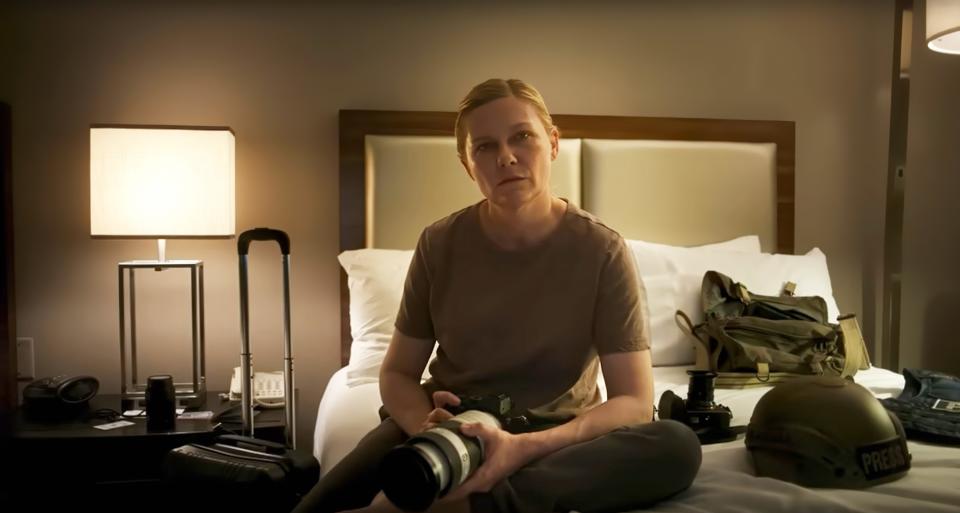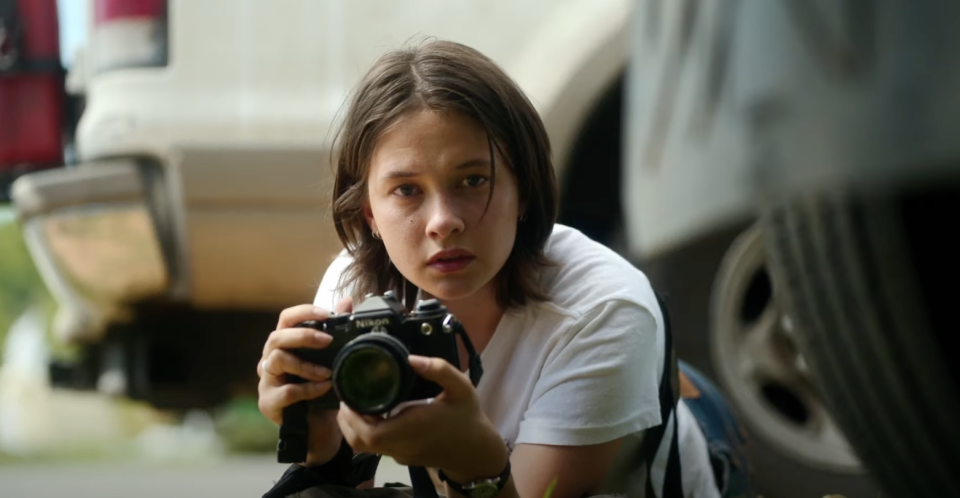‘Civil War’ Is About Photojournalists — So Its War Photography Had to Hurt

- Oops!Something went wrong.Please try again later.
Because the two protagonists of “Civil War” are war photographers, the A24 film’s script writes a check that director Alex Garland and especially cinematographer Rob Hardy need to cash. The movie is punctuated in key moments by in-world photography taken by Lee (Kirsten Dunst) and Jessie (Caliee Spaeny). It was important, therefore, to create compositions that would reflect how each of them sees America unraveling around them.
When we first meet her, Lee is already as legendary as actual WWII photographer Lee Miller, and there seems to be a distance and a sense of environment to the pictures she takes. One of the first things we watch her do is walk into the carnage of a suicide bombing. She’s putting herself in the midst of the bodies but constructing images where the story and the pain stretch well past the frame. Jessie, meanwhile, is completely new to the world of wartime reporting and finds herself drawn into the action. Her photos center the emotional details and she gets as close as she can without losing the wider context of the shot.
More from IndieWire
Taylor Swift Ends 'Tortured Poets Department' with 'Clara Bow' - Who Was She?
Quentin Tarantino Is No Longer Making 'The Movie Critic' as His 10th Film
Hardy’s work balances both characters’ impulses while giving the audience a visceral sense of the danger. This required building an environment and choosing camera systems that were as flexible as possible. Hardy found that having six Ronin 4Ds (well, five Ronin 4Ds, one was a casualty of the shoot) allowed the camera team to get as close to the perspective of the journalist characters in action sequences as possible without needing to truncate or interrupt the action. Then, for the moments of stillness and breath where we see how war has warped the landscape of the Atlantic seaboard, he used a Sony Venice 2.
“Since ‘Ex Machina,’ we’ve very much set the precedent that would create these immersive environments and the cameras almost become secondary; the actors and everybody can walk into that environment and make it feel as authentic as possible. Which sounds like, well, wouldn’t that be a standard thing to do in all aspects of filmmaking? But surprisingly, it’s not,” Hardy told IndieWire.
The smaller Ronins allowed Hardy and his team to switch between handheld and Steadicam feels, as well as more elegantly composed shots. Therefore, they speak both the visual language of a road trip movie and the visual language of a combat film.

“I could sit back on wheels if I needed to and have another operator in amongst the action and see things from a distance a bit more globally and make decisions about framing,” Hardy said. “We were always working towards the idea that every single shot could be a still image if you went through each and every frame and picked that singular moment, and so the framing needed to be very important.”
All of Hardy and Garland’s work together features incredibly evocative, active framing, where details lurking in the background can betray the calm or cool geometry of the foreground. But the pair are especially adept at creating frames for “Civil War” that, in Hardy’s words, tell a story behind the image. We can catch the ghost of some intoxicating violence when the film lingers on an overpass that has both “Go Steelers” graffiti and a dead body hanging off the side. We know exactly how terrifying Jesse Plemons’ character is going to be when the glint of his red plastic sunglasses lines up on a diagonal with a dead body stuck in the back of a truck behind him.
Hardy wanted the look of “Civil War” to be “visually abrasive, and I mean that in the best possible way. But then we also like to sit back and have our kind of surrealist moments because who doesn’t love surrealism?”

However, the process of creating Jessie and Lee’s photography was precision itself. “We ended up using a high-speed camera, in this case it was a RED Raptor, to work through the image that [Lee or Jessie] might be taking,” Hardy said. “We’d create the scenario and then we’d attack it with our high-speed camera, frame the scenario in a way that feels like we’re moving towards the thing, and then we rest.”
Having the camera move closer — in an echo of what the photojournalists are always doing at risk to their own safety — and then rest gave “Civil War” maximum flexibility in finding the right still image out of the single millisecond from the high-speed camera. This was a collaboration between the camera team and the post team, whose ultimate job was to isolate Lee and Jessie’s stills and place them inside the film where they’d pack the most punch. “It was scripted, but at the same time, it was something that we really developed throughout,” Hardy said.
It also reverberates throughout the rest of “Civil War” and gives context to Dunst’s and Spaeny’s performances. How close the camera is to the characters, where it gives them space and where it almost smothers the world around them, is a huge part of how the audience knows how safe, in control, and connected Lee and Jessie feel.
“Ultimately, you have two still photographers, and we need to tell their story,” Hardy said. “And we need to connect with what kind of eye they had. We had to develop their style, and that came purely from what [Dunst and Spaeny] were doing.”
Best of IndieWire
The 22 Best Spy Movies, from 'Enemy of the State' to 'North by Northwest'
The 12 Best Thrillers Streaming on Netflix in April, from 'Fair Play' to 'Emily the Criminal'
Quentin Tarantino's Favorite Movies: 61 Films the Director Wants You to See
Sign up for Indiewire's Newsletter. For the latest news, follow us on Facebook, Twitter, and Instagram.

